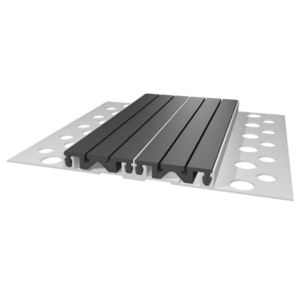


































Expansion Profiles: Movement Spaces and Strong Insulation Solutions in Buildings
Expansion profiles are applied to expansion joints created to allow different sections of large and wide structures to move independently. Stresses caused by floor movements, thermal expansion, contraction, or earthquakes can lead to structural damage and cracks. To prevent these issues, expansion joints are formed in various parts of the structure, and expansion profiles are used to ensure the safety and flexibility of the building.
These profiles also improve the durability of buildings with water, thermal, and sound insulation properties. Additionally, they provide an aesthetic appearance and can be used in areas such as floors, walls, ceilings, and facades.
Types of Expansion Profiles and Their Applications
Floor Expansion Profiles Floor expansion profiles are used in areas exposed to pedestrian or vehicle traffic. These profiles prevent cracks and damage by maintaining movement capabilities and are made from durable materials such as aluminum, stainless steel, and PVC, offering high mechanical durability.
Applications: Shopping malls, parking lots, airports, hotels, hospitals, industrial areas.
Wall Expansion Profiles Wall expansion profiles are used to balance the stresses that occur on wall surfaces and prevent cracks. They allow independent movement of the walls, while providing water and thermal insulation, enhancing the structure’s durability.
Applications: Interior walls, industrial structures, hotels, hospitals, office buildings.
Ceiling Expansion Profiles Ceiling expansion profiles balance the effects of expansion and contraction on ceiling surfaces, preventing cracks and damage. These profiles, typically made of aluminum or PVC, offer easy installation and an aesthetic appearance.
Applications: Interior ceilings, shopping malls, office buildings, conference halls.
Facade Expansion Profiles Facade expansion profiles absorb the movements on the building’s exterior and provide protection against external factors. Made from materials resistant to UV rays, water, and moisture, these profiles also enhance the aesthetic appearance of the building’s outer surface.
Applications: Facade cladding, high-rise buildings, industrial structures, commercial buildings.
Waterproof Expansion Profiles Waterproof expansion profiles are designed to provide excellent water resistance. They are used in areas exposed to water, such as floors or basements, to protect the structure from water leakage. Made from rubber or water-resistant elastic materials, these profiles offer long-lasting insulation solutions.
Applications: Swimming pools, basements, terraces, water tanks.
Advantages of Expansion Profiles
Support Structural Movement: They absorb expansion and contraction movements, preventing cracks and damage.
Insulation Properties: Enhance the structure’s durability with water, sound, and thermal insulation.
Aesthetic Contribution: Provide a modern and clean look while blending seamlessly with the structure.
Long Lifespan: Made from durable materials, expansion profiles offer long-term protection.
Easy Installation: Provide easy and quick installation on various surfaces.
Factors to Consider When Choosing Expansion Profiles
When selecting expansion profiles, the building’s purpose, environmental factors, and the profile’s durability should be considered. For example, floor profiles require high mechanical durability, while facade profiles should resist UV rays and moisture. Additionally, waterproof expansion profiles should be used in areas requiring water resistance to protect the structure.
Conclusion
Expansion profiles provide long-lasting and durable solutions by controlling structural movements in buildings. They increase the safety of the structure and protect it from external factors, making them indispensable in architectural and technical projects by combining aesthetic appeal and performance.